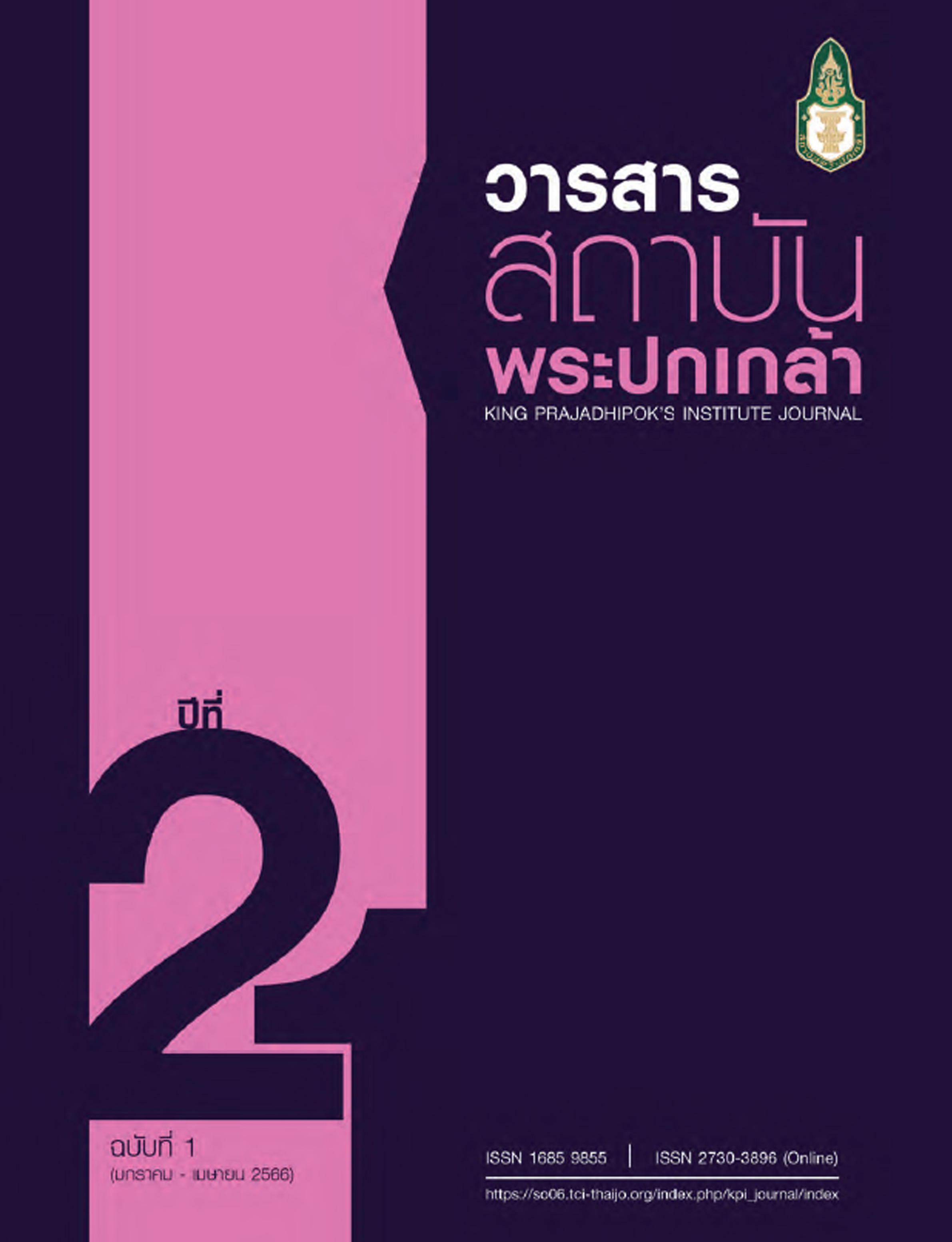การเสริมสร้างพลังอำนาจทางกฎหมายแก่ชุมชนโดยการประยุกต์ใช้อนุสัญญาว่าด้วยพื้นที่ชุ่มน้ำ (แรมซาร์) ในพื้นที่ชุ่มน้ำอิงตอนล่าง จังหวัดเชียงราย
Main Article Content
บทคัดย่อ
การวิจัยมีวัตถุประสงค์ เพื่อศึกษากระบวนการขึ้นทะเบียนพื้นที่ชุ่มน้ำตามอนุสัญญาว่าด้วยพื้นที่ชุ่มน้ำ (แรมซาร์) ในพื้นที่ชุ่มน้ำอิงตอนล่าง จังหวัดเชียงราย และวิเคราะห์รูปแบบการเสริมสร้างพลังอำนาจทางกฎหมายแก่ชุมชนในการจัดการพื้นที่ชุ่มน้ำ โดยกระบวนการมีส่วนร่วมของพหุภาคี เป็นการวิจัยเชิงคุณภาพด้วยวิจัยปฏิบัติการใน 7 ชุมชนในอำเภอขุนตาลและอำเภอเชียงของ จังหวัดเชียงราย เครื่องมือในการวิจัย คือ แนวคำถามในการสนทนากลุ่ม และสัมภาษณ์ผู้ให้ข้อมูลหลักที่มีส่วนได้เสียในการขึ้นทะเบียนพื้นที่ชุ่มน้ำ จำนวน 5 กลุ่ม ได้แก่ แกนนำชุมชนที่เป็นทางการและไม่เป็นทางการ ผู้บริหารองค์กรปกครองส่วนท้องถิ่น ตัวแทนหน่วยงานภาครัฐ ภาคประชาสังคม และสถาบันการศึกษา รวม 40 คน ในการวิเคราะห์ข้อมูลใช้วิธีการวิเคราะห์เนื้อหา โดยการสรุปสาระสำคัญ การจัดประเภทหมวดหมู่ของข้อมูล การตรวจสอบความถูกต้องของข้อมูล แล้วสรุปข้อมูลตามวัตถุประสงค์การวิจัย
ผลการวิจัยพบว่า 1) กระบวนการขึ้นทะเบียนพื้นที่ชุ่มน้ำตามอนุสัญญาว่าด้วยพื้นที่ชุ่มน้ำ (แรมซาร์) ในพื้นที่ชุ่มน้ำอิงตอนล่าง จังหวัดเชียงราย เป็นไปตามขั้นตอนการเสนอขอขึ้นทะเบียนพื้นที่ชุ่มน้ำเป็นพื้นที่
ชุ่มน้ำที่มีความสำคัญระดับชาติ ระดับนานาชาติ และระหว่างประเทศ โดยศึกษาเฉพาะขั้นตอนในระดับจังหวัด ซึ่งเป็นขั้นตอนแรกที่สำคัญของการขึ้นทะเบียนพื้นที่ชุ่มน้ำ เพื่อให้ได้มีแนวทางการดำเนินงานที่ชัดเจน ในขั้นตอนระดับจังหวัดสู่การรับรองการขึ้นทะเบียน เพื่อให้สำนักงานนโยบายและแผนทรัพยากรธรรมชาติและสิ่งแวดล้อมพิจารณาดำเนินการต่อไป 2) การเสริมสร้างพลังอำนาจทางกฎหมายแก่ชุมชนในการจัดการพื้นที่ชุ่มน้ำ โดยกระบวนการมีส่วนร่วมของพหุภาคี ได้แก่ (1) ด้านการมีส่วนร่วมที่มีการแบ่งบทบาทความรับผิดชอบของแต่ละภาคส่วนในการดำเนินงาน (2) ด้านการเสริมสร้างศักยภาพทางกฎหมายเป็นการสร้างพื้นที่สาธารณะทางกฎหมาย เพื่อให้ภาคีทุกภาคส่วนและคนในชุมชนเข้ามาแลกเปลี่ยนข้อมูลข่าวสาร และเสนอความคิดเห็น (3) ด้านการปฏิรูปแนวนโยบายและกฎหมาย โดยมีข้อเสนอในการทบทวนกฎหมายบางประเด็นที่เกี่ยวข้องกับการบริหารจัดการพื้นที่ชุ่มน้ำของประเทศไทย เพื่อให้เกิดมาตรการทางกฎหมายในการปกป้องพื้นที่ชุ่มน้ำที่มีความสอดคล้องกับวิถีชีวิตของคนในชุมชน และ (4) ด้านข้อมูลที่มีการบูรณาการองค์ความรู้ท้องถิ่นกับความรู้สหสาขาวิชา มีการจัดทำข้อมูลในรูปแบบของงานวิจัยไทบ้าน และทำกิจกรรมที่บูรณาการองค์ความรู้ภูมิปัญญาท้องถิ่นกับความรู้ทางวิทยาศาสตร์ โดยการหนุนเสริมจากสถาบันการศึกษา
Article Details

อนุญาตภายใต้เงื่อนไข Creative Commons Attribution-NonCommercial-NoDerivatives 4.0 International License.
@ 2020 King Prajadhipok's Institute The Government Complex Commemorating All Right Reserved.
เอกสารอ้างอิง
ภาษาไทย
ธีระพงศ์ โพธิมั่น และคณะ. (2564). พื้นที่ชุ่มน้ำลุ่มน้ำอิงกับการกักเก็บคาร์บอนเครดิต. เชียงใหม่: วนิดาการพิมพ์.
นิตยา โพธิ์นอก. (2556). นโยบายเกี่ยวกับสิทธิชุมชนในประเทศไทย. รายงานการวิจัย. กรุงเทพฯ: สํานักวิจัยและพัฒนา สถาบันพระปกเกล้า.
นักสิทธิ์ สังข์จันทร์. (2559). อนุสัญญาแรมซาร์ (Ramsar Convention) เอกสารประกอบการเสนอพื้นที่ชุ่มน้ำแม่น้ำสงครามตอนล่าง ขึ้นทะเบียนเป็นพื้นที่แรมซาร์ไซต์. กรุงเทพฯ: องค์การสัตว์ป่าโลก- ประเทศไทย.
ปาริชาติ วลัยเสถียร. (2549). กระบวนการและเทคนิคการทำงานของนักพัฒนา. กรุงเทพฯ: โครงการเสริมสร้างการเรียนรู้เพื่อชุมชนเป็นสุข (สรส.).
มิ่งขวัญ คงเจริญ. (2555). การพัฒนารูปแบบการเสริมสร้างพลังอำนาจชุมชนเพื่อเสริมสร้างจิตสำนึกของความเป็นพลเมืองที่ดีในวิถีประชาธิปไตย (รายงานการวิจัย). กรุงเทพฯ: สำนักงานเลขาธิการสภาผู้แทนราษฎร.
ศุภวุฒิ โมกข์เมธากุล. (2559). ปัญหาและอุปสรรคทางกฎหมายในการให้ความคุ้มครองพื้นที่
ชุ่มน้ำ. วารสารมนุษยศาสตร์และสังคมศาสตร์ มหาวิทยาลัยมหาสารคาม, 35(3),
-148.
สายัณน์ ข้ามหนึ่ง. (2560). ทำไมต้องผลักดันการขึ้นทะเบียนพื้นที่ชุ่มน้ำในลุ่มน้ำอิง. เชียงใหม่:สมาคมแม่น้ำเพื่อชีวิต.
สถาบันวิจัยวิทยาศาสตร์และเทคโนโลยีแห่งประเทศไทย (วว.). (2558). โครงการเพิ่มประสิทธิภาพการจัดการพื้นที่ชุ่มน้ำของประเทศไทย. กรุงเทพฯ: สำนักงานนโยบายและแผนทรัพยากรธรรมชาติและสิ่งแวดล้อม.
สมาคมแม่น้ำเพื่อชีวิต. (2560). ป่าชุ่มน้ำในลุ่มน้ำอิงตอนล่างและการจัดการโดยชุมชนท้องถิ่น. เชียงใหม่: วนิดาการพิมพ์.
สหัทยา วิเศษ. (2560). สภาประชาชนลุ่มน้ำอิง : พลวัตภาคประชาสังคมในการจัดการทรัพยากรธรรมชาติในลุ่มน้ำอิง (รายงานการวิจัย). พระนครศรีอยุธยา: มหาวิทยาลัย
มหาจุฬาลงกรณราชวิทยาลัย.
สำนักงานคณะกรรมการส่งเสริมการลงทุน. (2558). คู่มือการลงทุนในเขตเศรษฐกิจพิเศษ. กรุงเทพฯ: สำนักงานคณะกรรมการส่งเสริมการลงทุน.
สํานักงานนโยบายและแผนทรัพยากรธรรมชาติและสิ่งแวดล้อม. (2563ก). นิยามความหมายพื้นที่ชุ่มน้ำ. สืบค้นจาก http://wetlands.onep.go.th/wetland/aboutus/define
. (2563ข). รายงานการประชุมคณะทำงานวิชาการพื้นที่ชุ่มน้ำ ครั้งที่ 2/2563. สํานักงานนโยบายและแผนทรัพยากรธรรมชาติและสิ่งแวดล้อม.
. (2558). พื้นที่ชุ่มน้ำคืออะไร. สืบค้นจาก http://wetlands.onep.go.th/wetland/
aboutus/define.
อุทัย ปริญญาสุทธินันท์. (2561). การพัฒนาชุมชน แนวคิดและทฤษฎีการพัฒนา ประเด็นปัจจุบันและกรณีศึกษา. กรุงเทพฯ: โรงพิมพ์แห่งจุฬาลงกรณ์มหาวิทยาลัย.
ภาษาอังกฤษ
Dugan, Patrick J. (1990). Wetland Conservation: A Review of Current Issues and Required Action. IUCN: Gland, Switzerland.
Rissel, C. (1994). Empowerment: The Holy Grail of Health Promotion?. Health Promote International, 9(1), 39–47.
Schuftan, C. (1996). The Community Development Dilemma: What is Really Empowering?. Community development Journal, 31(3), 260-264.


